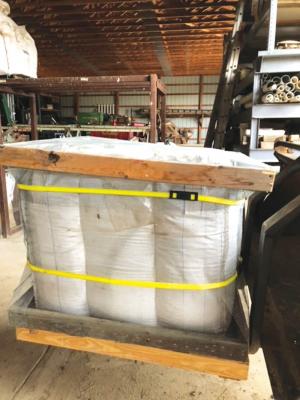2024 - Volume #48, Issue #5, Page #38
[ Sample Stories From This Issue | List of All Stories In This Issue | Print this story
| Read this issue]
Made-It-Myself Grain Bag Cap Keeps Rodents Out
 |
“What started all this was a need for long-term grain storage,” says Doerr. “I was asked to grow buckwheat for a friend who processes it into buckwheat flour. He doesn’t go through it that fast, so I knew I’d be storing the stuff for at least a year, maybe two. And like with most farms, storage space is at a premium.”
Rodents quickly took advantage. “I just got so tired of the mice being inside the grain bags,” says Doerr. “These bags aren’t made for long-term storage—the mice have too much time to chew them. I’ve found three generations of mice living in one bag before!”
Doerr came up with the idea of putting a cap over the top of the bag where the material is thinnest and then using strings to tie up the bag. “The cap I had in mind consisted of a 48-in. square frame covered with hardware cloth. Then, I thought that 8-in. pieces cascading down from each side would be enough to cover the entire top of the bag.” He had his friend and hired hand Al Verhaeghe put it together. “I design, and he builds.”
Their first attempt had 8 in. sides and succeeded in covering the top but left very little wire to wrap a binder strap around. “For the second frame, we stayed with the 48-in. square top and went to 12-in. sides, but it still left very little room for the strap,” says Doerr. “While testing the frame on a grain bag full of wheat from last year, we noticed holes near the bottom of another bag and decided we needed to cover the entire bag. That meant two frames and longer wire for the sides.”
When the bags were full, they stood almost 4 ft. tall. This meant they needed sides to be at least 24 in. from the top and bottom to cover the entire thing, which created overlap in the center. “That’s not a bad thing because this is where the binder strap would go, and we could use one per bag instead of two,” says Doerr. “One benefit of this project was that we could use up several old 2 by 4s from previous projects.”
At this point, they had a top and bottom with 24-in. sides. “We put the bottom half on a pallet and used the front-end loader to put the bag in place,” he says. “Then we placed the top on it and attached the binder strap around the middle. There was a gap around the corners, so we looped some extra wire around each side and tightened them to seal the gap.”
Doerr and Verhaeghe are impressed with the functionality of their grain bag cage so far. “We’ve already built five of them,” says Doerr. “Will it work as a cure for all the rodent problems? Maybe not. But it definitely takes them longer to chew their way inside the grain bags, and that’s what I was looking for.”
Contact: FARM SHOW Followup, Al Verhaeghe (ajverhaeghe@hotmail.com).

Click here to download page story appeared in.

Click here to read entire issue
To read the rest of this story, download this issue below or click here to register with your account number.




